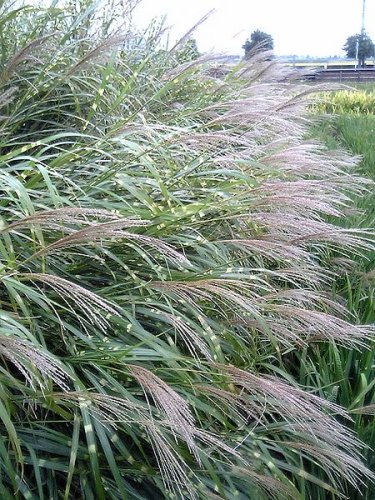Miscanthus Gardening Tips   
| ||||
|
Miscanthus is a genus of grasses in the family Poaceae, comprising 15 species. It is native to tropical and subtropical regions of Africa and southern Asia, with one species (M. sinensis) occurs in temperate eastern Asia. Miscanthus is a deciduous grass with variegated foliage and attractive inflorescences, and the inflorescences can be left on the plants to provide winter intererst. Many of the most widely available forms have been developed from Miscanthus sinensis. Miscanthus sinensis (Chinese silver grass, Eulalia grass, Maiden grass, Zebra grass, Susuki grass, Porcupine grass) is a grass native to eastern Asia throughout most of China, Japan, and Korea. It is a deciduous and herbaceous perennial plant growing to 4 x 1.2 m, forming dense clumps from an underground rhizome. The leaves are blue-grey and in autumn, large panicles of pale-grey, purple-tinged spikelets are borne above the foliage. M. sinensis is cultivated as an ornamental plant in temperate regions around the world. It has become an invasive species in parts if North America. In Japan, it is considered an iconic plant of late summer and early autumn. M. 'Goliath' can grow up to 2.1 m tall, has green leaves and pink-tinged inflorescences in late summer. M. 'Gracillimus' (Maiden grass), 1.3 m tall, has narrow leaves that curls at the end and have white midribs and, in autumn, bears plumes of buff-yellow spikelets. The leaves also change to bronze color in autmn. Miscanthus is trouble-free and grows well in full sun, in moisture-retentive but well drained soil. Propagation is by seed or division in spring.  Miscanthus sinensis Author: Koba-chan (Creative Commons Attribution ShareAlike 3.0) Miscanthus sinensis Author: KENPEI (Creative Commons Attribution-Share Alike 2.1 Japan) Miscanthus sinensis Author: KENPEI (Creative Commons Attribution-Share Alike 2.1 Japan) Miscanthus 'Gracillimus' Author: KENPEI (Creative Commons Attribution-Share Alike 2.5 Generic) | ||||
|


